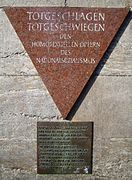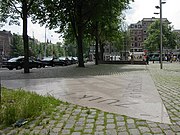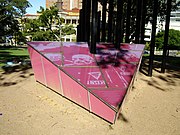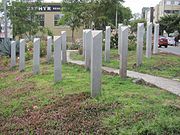Pink triangle: Difference between revisions
→Gay rights symbol: Clarify that queer communities were insiders. Tags: Mobile edit Mobile web edit |
Indicate “homosexual men” is a euphemism with scare quotes Tags: Mobile edit Mobile web edit |
||
| Line 1: | Line 1: | ||
{{About||the Weezer song|Pink Triangle (song)|the British audio manufacturer|Pink Triangle (audio manufacturer)}} |
{{About||the Weezer song|Pink Triangle (song)|the British audio manufacturer|Pink Triangle (audio manufacturer)}} |
||
[[File:Pink triangle.svg|thumb|A pink triangle in the traditional orientation]]{{LGBT symbols}} |
[[File:Pink triangle.svg|thumb|A pink triangle in the traditional orientation]]{{LGBT symbols}} |
||
In [[Nazi Germany]], a '''pink triangle''' ({{lang-de|Rosa Winkel}})<ref>{{cite web | url=http://www.dict.cc/german-english/rosa.html | title=English-German Dictionary | work=dict.cc | accessdate=November 16, 2013}}</ref> was used as one of the [[Nazi concentration camp badges]]. A pink triangle was used to identify prisoners persecuted for their gender or sexuality who were sent to camps because they had been identified by authorities as [[homosexuality|homosexual]] men,<ref>Plant, ''The Pink Triangle''</ref><ref name=Plant1988/> a definition which at the time included [[Trans woman|transgender women]].<ref name=tgdor>{{Cite web|url=http://tgdor.org/holocaust.shtml|title=2008 Houston Transgender Day of Remembrance: Transgenders and Nazi Germany|last=Williams|first=Cristan|website=tgdor.org|access-date=2018-08-24}}</ref> Intended as a [[badge of shame]], the pink triangle has since been [[Reappropriation|reclaimed]] as an international symbol of [[gay pride|LGBT pride]] and the [[LGBT rights]] movement.<ref>{{cite web |last1=Shankar |first1=Louis |title=How the Pink Triangle Became a Symbol of Queer Resistance |url=https://hiskind.com/how-the-pink-triangle-became-a-symbol-of-queer-resistance/ |website=HISKIND |accessdate=August 22, 2018 |date=April 19, 2017}}</ref><ref>{{cite news |last1=Waxman |first1=Olivia B. |title=How the Nazi Regime's Pink Triangle Symbol Was Repurposed for LGBTQ Pride |url=http://time.com/5295476/gay-pride-pink-triangle-history/ |accessdate=August 22, 2018 |work=TIME |date=May 31, 2018 |language=en}}</ref> |
In [[Nazi Germany]], a '''pink triangle''' ({{lang-de|Rosa Winkel}})<ref>{{cite web | url=http://www.dict.cc/german-english/rosa.html | title=English-German Dictionary | work=dict.cc | accessdate=November 16, 2013}}</ref> was used as one of the [[Nazi concentration camp badges]]. A pink triangle was used to identify prisoners persecuted for their gender or sexuality who were sent to camps because they had been identified by authorities as "[[homosexuality|homosexual]] men,"<ref>Plant, ''The Pink Triangle''</ref><ref name=Plant1988/> a definition which at the time included [[Trans woman|transgender women]].<ref name=tgdor>{{Cite web|url=http://tgdor.org/holocaust.shtml|title=2008 Houston Transgender Day of Remembrance: Transgenders and Nazi Germany|last=Williams|first=Cristan|website=tgdor.org|access-date=2018-08-24}}</ref> Intended as a [[badge of shame]], the pink triangle has since been [[Reappropriation|reclaimed]] as an international symbol of [[gay pride|LGBT pride]] and the [[LGBT rights]] movement.<ref>{{cite web |last1=Shankar |first1=Louis |title=How the Pink Triangle Became a Symbol of Queer Resistance |url=https://hiskind.com/how-the-pink-triangle-became-a-symbol-of-queer-resistance/ |website=HISKIND |accessdate=August 22, 2018 |date=April 19, 2017}}</ref><ref>{{cite news |last1=Waxman |first1=Olivia B. |title=How the Nazi Regime's Pink Triangle Symbol Was Repurposed for LGBTQ Pride |url=http://time.com/5295476/gay-pride-pink-triangle-history/ |accessdate=August 22, 2018 |work=TIME |date=May 31, 2018 |language=en}}</ref> |
||
== History== |
== History== |
||
Revision as of 01:04, 26 August 2018

| Part of the LGBTQ series |
| LGBTQ symbols |
|---|
| Symbols |
| Pride flags |
In Nazi Germany, a pink triangle (German: Rosa Winkel)[1] was used as one of the Nazi concentration camp badges. A pink triangle was used to identify prisoners persecuted for their gender or sexuality who were sent to camps because they had been identified by authorities as "homosexual men,"[2][3] a definition which at the time included transgender women.[4] Intended as a badge of shame, the pink triangle has since been reclaimed as an international symbol of LGBT pride and the LGBT rights movement.[5][6]
History
Nazi prisoner identification
In Nazi concentration camps, each prisoner was forced to wear a triangular concentration camp badge on their chest, the color of which identified the reason for their imprisonment.[7] Inmates identified as "homosexuals", including gay and bisexual men, transgender women and intersex people who had been assigned-male-at-birth, wore a pink inverted equilateral triangle.[4] Lesbians and trans men did not wear a pink triangle.[8][9] If a prisoner was also identified as Jewish, the triangle was superimposed over an inverted yellow second triangle to resemble the Star of David.
While the number assigned a pink triangle in German concentration camps is hard to estimate, Richard Plant gives a rough estimate of the number convicted for homosexuality "between 1933 to 1944 at between 50,000 and 63,000."[3]
After the camps were liberated at the end of the Second World War, many of the prisoners imprisoned for homosexuality or their gender expression were re-incarcerated by the Allied-established Federal Republic of Germany.[citation needed] An openly homosexual man named Heinz Dörmer, for instance, served 20 years total, first in a Nazi concentration camp and then in the jails of the new Republic.[citation needed] The Nazi amendments to Paragraph 175, which turned homosexuality from a minor offense into a felony, remaining intact in East Germany until 1968[10] and in West Germany until 1969.[11] West Germany continued to imprison those identified as homosexual until 1994 under a revised version of the Paragraph, which still made sexual relations between men up to the age of 21 – as well as male homosexual prostitution – illegal. [12] While law suits seeking monetary compensation have failed, in 2002 the German government issued an official apology to the LGBT community.[13]
On August 3, 2011 Rudolf Brazda, one of the last known homosexual concentration camp survivors, died at the age of 98.[14]
Gay rights symbol

In 1972, gay concentration camp survivor Heinz Heger's memoir Die Männer mit dem rosa Winkel (The Men with the Pink Triangle) increased public awareness of the pink triangle symbol.[15] For example, in the 1975 movie The Rocky Horror Picture Show, the bisexual, transvestite[16][17] main character Dr. Frank N. Furter wears a pink triangle badge on one of his outfits.[18] By the end of the 1970s, the pink triangle was being adopted in queer communities as a symbol for gay rights protests.[19][20]
In the 1980s, it was widely used – sometimes discretely, as an "insider" code – as a symbol within queer communities for gay and lesbian organizations, businesses, and individuals. The AIDS Coalition To Unleash Power (ACT UP) adopted an upward-pointing pink triangle along with the slogan "SILENCE = DEATH" as its logo shortly after its formation by six gay activists in New York City in 1987.[21][22] Some use the triangle in this orientation as a specific "reversal" of its usage by the Nazis.[23][24][25] The Pink Panthers Movement in Denver, Colorado adopted a pink triangle with clawed panther print logo, adapted from the original Pink Panthers Patrol in New York City.[citation needed]
A pink triangle enclosed in a green circle was adopted as a symbol identifying "safe spaces" for LGBT people.[26]
The pink triangle served as the basis for the "biangles", a symbol of bisexual identity which consists of a pink and blue triangles overlapping in a lavender or purple area. The pink and blue symbolize either homosexuality and heterosexuality, or female and male gender, reflecting bisexuals' attraction to both.[27][28]
Monuments and memorials
The symbol of the pink triangle has been included in numerous public monuments and memorials. In 1995, after a decade of campaigning for it, a pink triangle plaque was installed at the Dachau Memorial Museum to commemorate the suffering of gay men and lesbians.[29] In 2015 a pink triangle was incorporated into Chicago's Legacy Walk.[30] It is the basis of the design of the Homomonument in Amsterdam and the Gay and Lesbian Holocaust Memorial in Sydney. In San Francisco it inspired both the Pink Triangle Park in the Castro and the 1-acre (4,000 m2) Pink Triangle on Twin Peaks that is displayed every year during Pride weekend.[31] It is also the basis for LGBT memorials in Barcelona, Sitges and Montevideo, and the burial component of the LGBT Pink Dolphin Monument in Galveston.
Until 1985 there was an unofficial ban on placing pink triangle wreaths at the United Kingdom war memorial the Cenotaph, and such wreaths were removed as soon as they were found by officials.[32]
- Some examples of the pink triangle from Nazi camps used in memorials
-
Pink triangle (Rosa Winkel in German) memorial for gay men killed at Buchenwald.
-
In the Berlin Nollendorfplatz subway station, a pink triangle plaque honors gay male victims. (Photo by: Manfred Brueckels.)
-
Amsterdam's Homomonument uses pink triangles symbolically to memorialize gay men killed in the Holocaust (and also victims of anti-gay violence generally).
See also
- Bent (play)
- Black triangle
- Nazi concentration camp badges
- Persecution of homosexuals in Nazi Germany and the Holocaust
- Gay concentration camps in Chechnya, Russia, in 2017
- Pink Triangle Trust
- Purple triangle
- Paragraph 175
- Sexuality and gender identity-based cultures
- Il Rosa Nudo (Naked Rose), a film by Giovanni Coda based on Pierre Seel's life.
- Sounds from the Fog, a film by Klaus Stanjek based on Wilhelm Heckmann's biography.
- Arizona SB 1062
- National Socialist League (United States), a former neo-Nazi political party for gay men
References
- ^ "English-German Dictionary". dict.cc. Retrieved November 16, 2013.
- ^ Plant, The Pink Triangle
- ^ a b Plant, Richard (1988). The pink triangle: the Nazi war against homosexuals (revised ed.). H. Holt. p. 175. ISBN 978-0-8050-0600-1.
{{cite book}}: CS1 maint: postscript (link) - ^ a b Williams, Cristan. "2008 Houston Transgender Day of Remembrance: Transgenders and Nazi Germany". tgdor.org. Retrieved 2018-08-24.
- ^ Shankar, Louis (April 19, 2017). "How the Pink Triangle Became a Symbol of Queer Resistance". HISKIND. Retrieved August 22, 2018.
- ^ Waxman, Olivia B. (May 31, 2018). "How the Nazi Regime's Pink Triangle Symbol Was Repurposed for LGBTQ Pride". TIME. Retrieved August 22, 2018.
- ^ See Nazi concentration camp table of inmate markings
- ^ "Queer Women and AFAB People During the Holocaust". Making Queer History. Retrieved 2018-08-24.
- ^ "Lesbians and the Third Reich". Holocaust Encyclopedia. United States Holocaust Memorial Museum. Retrieved 24 August 2018.
- ^ James Kirchik (February 13, 2013). "Documentary Explores Gay Life in East Germany". Der Spiegel.
- ^ Clayton J. Whisnant (2012). Male Homosexuality in West Germany: Between Persecution and Freedom, 1945-69. pp. 201–203. ISBN 9780230355002.
- ^ Zowie Davy; Julia Downes; Lena Eckert (2002). Bound and Unbound: Interdisciplinary Approaches to Genders and Sexualities. pp. 141–142. ISBN 1443810851.
- ^ Melissa Eddy (May 18, 2002). "Germany Offers Nazi-Era Pardons". Associated Press.
- ^ Langer, Emily (7 August 2011). "Rudolf Brazda dies; gay man who survived Nazi concentration camp was 98". Washington Post. Retrieved 22 August 2018.
- ^ Jensen, Erik (2002). "The pink triangle and political consciousness: gays, lesbians, and the memory of Nazi persecution". Journal of the History of Sexuality. 11 (1 and 2).
{{cite journal}}: CS1 maint: postscript (link) - ^ Tribune, Andrew S. Hughes South Bend. "Sexuality, doo-wop major themes in 'The Rocky Horror Show'". South Bend Tribune. Retrieved 2018-08-26.
- ^ "The Astonishingly Non-Nonsensical Plot of The Rocky Horror Picture Show". Tor.com. 2012-10-31. Retrieved 2018-08-26.
- ^ Nash, Tara (2017-11-30). "Rated "R" for Resistance". Queerer Things. Retrieved 2018-08-24.
- ^ Gianoulis, Tina (2004). Claude J. Summers (ed.). "Pink Triangle". glbtq: An Encyclopedia of Gay, Lesbian, Bisexual, Transgender, and Queer Culture. Archived from the original on 2014-10-25. Retrieved 2014-09-26.
In the early 1970s, gay rights organizations in Germany and the United States launched campaigns to reclaim the pink triangle. In 1973 the German gay liberation group Homosexuelle Aktion Westberlin (HAW) called upon gay men to wear the pink triangle as a memorial.
{{cite web}}: Unknown parameter|deadurl=ignored (|url-status=suggested) (help) - ^ "Symbols of the Gay, Lesbian, Bisexual, and Transgender Movements". lambda.org. Lambda GLBT Community Services. 2004. Retrieved 2014-09-26.
- ^ Feldman, Douglas A. and Judith Wang Miller (1998). The AIDS Crisis: A Documentary History. Greenwood Publishing Group. ISBN 0-313-28715-5. p. 176
- ^ "SILENCE = DEATH". www.actupny.org.
- ^ "San Francisco Neighborhoods: The Castro" KQED documentary.
- ^ "This week in history: Recognizing the history of the pink triangle". People's World. PeoplesWorld.org. Retrieved 27 April 2018.
- ^ R. Amy Elman PhD (2010) Triangles and Tribulations:, Journal of Homosexuality, 30:3, 1-11, DOI: 10.1300/J082v30n03_01
- ^ "Safe Space – EQUAL!". equal.org. Retrieved 2018-08-24.
- ^ "ALGBTICAL". www.algbtical.org. Retrieved 2018-08-24.
- ^ Services, LAMBDA GLBT Community. "Gay, Lesbian, Bisexual, & Transgender Symbols". www.qrd.org. Retrieved 2018-08-24.
- ^ Brocklebank, Christopher (31 May 2011). "New memorial to gay holocaust victims to be built in Munich". Pink News. Retrieved 1 June 2011.
- ^ "Legacy Walk unveils five new bronze memorial plaques - 2342 - Gay Lesbian Bi Trans News - Windy City Times".
- ^ "The Pink Triangle, displayed annually on Twin Peaks in San Francisco during Pride weekend". Thepinktriangle.com. 2012-06-14. Retrieved 2013-02-12.
- ^ "Q&A: Peter Tatchell". Lush Fresh Handmade Cosmetics.
Further reading
- An Underground Life: Memoirs of a Gay Jew in Nazi Berlin (1999) by Gad Beck (University of Wisconsin Press). ISBN 0-299-16500-0.
- The Iron Words (2014) by Michael Fridgen (Dreamlly Publishing). ISBN 978-0-615-99269-3.
- Liberation Was for Others: Memoirs of a Gay Survivor of the Nazi Holocaust (1997) by Pierre Seel (Perseus Book Group). ISBN 0-306-80756-4.
- I, Pierre Seel, Deported Homosexual: A Memoir of Nazi Terror (1995) by Pierre Seel. ISBN 0-465-04500-6.
- Heinz Heger (1994). Men With the Pink Triangle: The True, Life-And-Death Story of Homosexuals in the Nazi Death Camps. Alyson Books. ISBN 1-55583-006-4.



